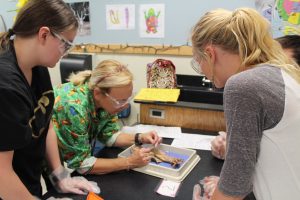Teens and Young Adults
 Adolescence is a transitional period between childhood and maturity, which developmental scientists increasingly see as extending from around 12 or 13 years all the way into young adulthood at 24 years. Sometimes it seems this period is actually two phases, adolescence followed by emerging adulthood between the ages 18 and 25. The extension captures changes in brain development that continue into the early twenties and also changing social conditions in our modern world, with prolonged education, delayed marriage and later childbearing among many groups of young people.
Adolescence is a transitional period between childhood and maturity, which developmental scientists increasingly see as extending from around 12 or 13 years all the way into young adulthood at 24 years. Sometimes it seems this period is actually two phases, adolescence followed by emerging adulthood between the ages 18 and 25. The extension captures changes in brain development that continue into the early twenties and also changing social conditions in our modern world, with prolonged education, delayed marriage and later childbearing among many groups of young people.
Many of the entries in this section of the site describe the traditional teen period, 13 – 18 years. Others focus on emerging adulthood, and these will be clearly indicated. Some posts relate to the full age range.
The teen years are characteristically inconsistent, with children this age sometimes acting (and expected to behave) in responsible, knowledgeable, independent ways and other times acting (and being treated as) dependent, immature and floundering. The years are often described as turbulent and feature not only cognitive, social, neurological and physical growth, but a great deal of self exploration as teens try to step confidently into a comfortable adult identity.
The period of emerging adulthood generally brings greater stability, though it is occasionally punctuated with feelings of being overwhelmed or uncertain. You may also find it brings a more open attachment between parent and young adult.
While parents sometimes fear teen years, expecting struggles and challenges, the connection between parent and teen can be very strong and secure. Teens often turn to peers, but parents and other adults remain important too; it is more a matter of expansion than of substitution.
 Teen Behavior: There may be some benefits in taking risks.
Teen Behavior: There may be some benefits in taking risks.
Grown-ups have noted since Aristotle, and probably before that as well, that teens tend to take more risks and to be less responsible than adults. It’s easy to write that off as immaturity and to tell ourselves that it is one of those proverbial “stages.” More recently, a rather provocative idea has been discussed in cognitive and neuro- psychology: risk taking may actually serve some adaptive purposes in helping teens to grow up. Read article
 Teen Brains: They’re complicated
Teen Brains: They’re complicated
Many people comment on the impulsiveness and irresponsibility of teens, but the picture is rather more complex. Teens also show considerable maturity in their thinking. This article provides a quick overview of some of the key developments associated with both sides of the picture and how they are related. Read article
 Teen Sleep Deprivations Part 1: The Reality
Teen Sleep Deprivations Part 1: The Reality
Sleeping in late, staying up late and always feeling tired isn’t just due to external factors, such as social activities, homework and TV or computer use. It isn’t only that. In the 1990s scientists found out the shift in sleep patterns has a large biological component stemming from changes in the way melatonin works. However, genes and behavior are also involved. Read article
 Teen Sleep Deprivation, part 2: Strategies for managing
Teen Sleep Deprivation, part 2: Strategies for managing
A list of practical suggestions that really work for helping your teen get needed sleep, while still honoring the natural bio-rhythm. Read article
Grown-ups have noted since Aristotle, and probably before that as well, that teens tend to take more risks and to be less responsible than adults. It’s easy to write that off as immaturity and to tell ourselves that it is one of those proverbial “stages.” More recently, a rather provocative idea has been discussed in cognitive and neuro- psychology: risk taking may actually serve some adaptive purposes in helping teens to grow up. Underlying this idea is a growing understanding of some of the neurotransmitters . . .
Many people comment on the impulsiveness and irresponsibility of teens, but the picture is rather more complex. Teens also show considerable maturity in their thinking. This article provides a quick overview of some of the key developments associated with both sides of the picture and how they are related.
Basics of brain development in adolescence
It is well known that brains develop in numerous ways during the period from early adolescence through young adulthood, roughly 12 – 24 years. This is largely a “re-wiring” process. While brains continue to change and develop throughout life, aside from infancy, the most dramatic growth spurt is during this adolescent period. Many of the changes involve creating better connections among different parts of the brain, which allows for better integration of information. There is also a lot of synaptic pruning, which eliminates some of the less efficient circuits among nerve cells and makes processing faster. Quite a bit of development occurs in the frontal cortex, largely myelination which speeds up transmission of signals between nerve cells. This area is crucial for decision making, problem solving and self-regulation.
The lure of pleasurable experiences
 At the beginning of adolescence, there is an increase of the neurotransmitter, dopamine. Dopamine is involved in emotional responses and with experiences of pleasure and reward. It is also associated with a seemingly contradictory set of features including competitiveness, aggression on the one hand, but also impulse control on the other.
At the beginning of adolescence, there is an increase of the neurotransmitter, dopamine. Dopamine is involved in emotional responses and with experiences of pleasure and reward. It is also associated with a seemingly contradictory set of features including competitiveness, aggression on the one hand, but also impulse control on the other.
The amount of dopamine in the brain increases when teens engage in exciting or thrilling activities. Dopamine provides a pleasurable reward for these activities and inclines teens to engage in, and seek out, exhilarating sensations and experiences. This pattern continues until at least middle adolescence, at roughly 18 years old. In all humans (and other creatures) dopamine both entices and enhances the drive for excitement and can lead to impulsive behavior.
This drive can be mediated by a form of cognitive control called executive function. During adolescence there is considerable development in a part of the frontal lobe of cerebral cortex associated with executive function (mainly in the dorso-lateral pre-frontal cortex). It has actually been developing throughout childhood, with some interesting expansion appearing even during infancy (12 – 18 months). In addition, in teens, new connections are built between the frontal cortex and other areas of the brain, particularly the hippocampus where certain aspects of memory are stored. These connections eventually integrate memories and reasoning, allowing a person to reflect and control impulses by thinking about the possible repercussions of behavior.
At the same time that adolescence experience heightened influences from dopamine, they also have a tendency to focus more on the potential positive outcomes of an activity and somewhat dismiss negative outcomes. Physician and writer Dan Siegal (2013), considers this an example of hyper-rationality. The term sounds as if it should mean very rational or particularly clever. In fact, it refers to a tendency to get caught up in one set of facts while ignoring others. An example is a tendency to keep buying a sinking stock because it had been performing well in the past, while ignoring information about why it is doing poorly now. Hyper-rational thinking in teens applies especially to emotional and social areas, for example focussing on the pleasurable reward of staying out with friends, while ignoring possible consequences of being tired or leaving homework unfinished.
Sophisticated thinking strategies are also present
 Impulsive or hyper-rational thinking is certainly not the only kind of thinking teens use. In cognitive areas in particular, teens are clearly able to use abstract thinking, logic and mature problem-solving skills. Students in high school use complex forms of reasoning and deduction to solve complex math, conduct science experiments, and analyze literature or history. So the teen actually has and uses advanced cognitive skills.
Impulsive or hyper-rational thinking is certainly not the only kind of thinking teens use. In cognitive areas in particular, teens are clearly able to use abstract thinking, logic and mature problem-solving skills. Students in high school use complex forms of reasoning and deduction to solve complex math, conduct science experiments, and analyze literature or history. So the teen actually has and uses advanced cognitive skills.
During emerging adulthood, roughly 18 to 24 years, decision-making expands to include more evaluation of both positive and negative consequences, and emphasis switches from those associated with the dopamine reward center, to broader values and goals. This kind of thinking extends logical problem-solving skills to personal and emotional domains.
Some developmentalists have pointed out that the risk-taking quality of thinking among teens may also serve an adaptive function. “Adapting” in this sense means that taking risks prepares one to try new things. Some of the changes of adolescence may help new kinds thinking and behavior to emerge to cope with the demands of adulthood. After a very long period of childhood, teens need to move from dependent juvenile lifestyles to competent independent ones. Pushing away to become fully responsible for one’s daily life takes courage. Some developmentalists suggest that risk taking behavior may help teens find the courage it takes to assume control as an independent adult. Seeing a possible possible adaptive advantage of taking risks extends ideas that cognitive immaturity in general may have some adaptive advantages. For example, the somewhat immature perceptual abilities of infants may protect them from becoming over stimulated, or young children’s tendencies to grossly overestimate their physical and cognitive abilities may encourage them to persist when they have minimal skill. (The general idea is well described in Bjorklund,1997.)
Inconsistency in the hallmark of teenage thinking and behavior
While there is a lot of talk in both the popular press and in science about brain changes, immaturity, and risk-taking in teens, it is also important to recognize that responsible, thoughtful behavior is also present. A major feature of adolescent thinking and behavior is its inconsistency. A teen may show careful planning and responsible behavior one day, and irresponsible or even reckless behavior the next: one day stepping up to manage the household when a parent is ill, or brilliantly and diligently completing a demanding assignment; and the next day forgetting to do important tasks or partying late, while ignoring curfews and family rules.
Inconsistency is a hallmark of adolescence. One reason for inconsistency is the swing between relying on well-developed cognitive problem-solving some of the time and being governed by emotional responses and the dopamine reward center other times.
And then there are peers
 Added to this is peer influence. During teen years and emerging adulthood, people shift from family centered to more peer centered social networks. This has ramifications. One recurring finding in developmental research is that impulsive behavior is most common when teens are together, directly or indirectly egging one another on. Teens are more likely to take risks when they are with peers in social situations. The flip side of this though, is that studies also show that teens who work together to collaboratively solve problems, such as cooperating on school projects, science experiments or planning fund raising events, use more sophisticated reasoning than those who work alone. The explanation for this is thought to be socio cognitive conflict, in which conflicts and challenges raised by working through different perspectives and ideas helps people to think in new or clearer ways. So, as with many other things, peer influences can be both very positive or very negative depending on circumstances.
Added to this is peer influence. During teen years and emerging adulthood, people shift from family centered to more peer centered social networks. This has ramifications. One recurring finding in developmental research is that impulsive behavior is most common when teens are together, directly or indirectly egging one another on. Teens are more likely to take risks when they are with peers in social situations. The flip side of this though, is that studies also show that teens who work together to collaboratively solve problems, such as cooperating on school projects, science experiments or planning fund raising events, use more sophisticated reasoning than those who work alone. The explanation for this is thought to be socio cognitive conflict, in which conflicts and challenges raised by working through different perspectives and ideas helps people to think in new or clearer ways. So, as with many other things, peer influences can be both very positive or very negative depending on circumstances.
The whole picture is quite complex
 The picture that has emerged during the last decade is that brain development extends into early adulthood, and along with it young adults gain increasing competence in using their highly sophisticated brains and integrating information from different domains. They also gain proficiency and skill in exercising conscious control of competing impulses. At the same time, there is an emerging appreciation that some of the tasks of adolescence may actually be advanced by thinking and behavior that seems at times quite rash. The decade-long period of neurological, cognitive, social and emotional development that extends from sexual maturity to full adulthood is not simply a form of immaturity. It is highly complex and involves both sophisticated thinking and seemingly unsophisticated impulsive behavior, which may in itself serve important adaptive functions for promoting independence.
The picture that has emerged during the last decade is that brain development extends into early adulthood, and along with it young adults gain increasing competence in using their highly sophisticated brains and integrating information from different domains. They also gain proficiency and skill in exercising conscious control of competing impulses. At the same time, there is an emerging appreciation that some of the tasks of adolescence may actually be advanced by thinking and behavior that seems at times quite rash. The decade-long period of neurological, cognitive, social and emotional development that extends from sexual maturity to full adulthood is not simply a form of immaturity. It is highly complex and involves both sophisticated thinking and seemingly unsophisticated impulsive behavior, which may in itself serve important adaptive functions for promoting independence.
Coincident with some dramatic brain development, this is also the time when teens and emerging adults:
Explore and try out different possible identities
Push toward independence
Connect in deeper more meaningful ways to peers, creating close friendship bonds, and later meeting prospective partners
While sometimes stressful, to both teens and the adults around them, this is also joyful time. Teens thrive on fun and their exuberance is associated with joy as well as with risk-taking.
This is the first of several articles on neurological and related development in teens. Future articles will provide detailed discussions of thinking, emotional and social development during adolescences and emerging adulthood.
References
Bjorklund, D. F. (1997). The role of immaturity in development. Psychological Bulletin, 122, 153-169.
Siegel, D. (2013). Brainstorm: The power and purpose of the teenage brain. New York: Penguin Group.
These are some of the effects of sleep deprivation in teenagers
* lower grades, greater difficulty learning and paying attention, slower cognitive skills.
* more auto accidents for various reasons, including slower reaction time, drowsiness and difficulty paying attention
* poor decision making and greater likelihood of giving into to peer pressure
* greater vulnerability to psychological problems including depression, risk taking behavior, violence and problems controlling emotions
* impaired coordination, affecting sports and everyday activities
* irritability
* Long term effects include compromised immune systems, lethargy . . .
Teens are notorious for sleeping in late, staying up late and always feeling tired. They seem very different from their younger selves. Younger children hop out of bed near dawn and usually drift off to sleep by 8PM. Parents and researchers have long noticed this change in sleep style and assumed it was due to external factors, such as social activities, homework and TV or computer use. It isn’t only that. In the 1990s scientists found out the shift in sleep patterns has a large . . .
